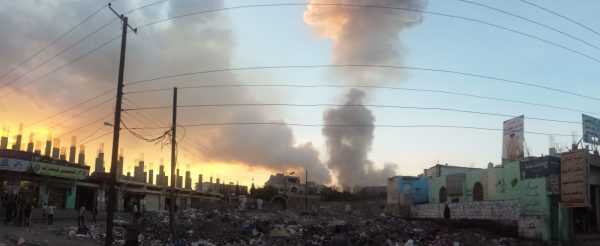Ongoing fighting and blockades on humanitarian aid leave Yemenis with few options.

An airstrike in Sana’a, Yemen. Photo courtesy of Wikimedia Commons.
By Kayla Cragg, Circle of Blue – April 20, 2017
The Rundown
Since March 2015, civil war between Houthi rebels and a pro-government coalition has raged in Yemen. This conflict, which has been mostly overlooked by the international community and largely overshadowed by conflict in Syria and Iraq, has now pushed Yemen to the brink of famine. In order to avert disaster, huge amounts of humanitarian assistance are needed, but aid appeals remain grossly underfunded. Yemen’s warring parties have also proved hostile toward humanitarian efforts, with reports of aid workers being detained and attacked. Currently, 6.8 million Yemenis need emergency assistance and countless others are struggling to obtain food, water, shelter, and medicine.
“The problem is that you see the numbers but you don’t see the people behind it. I’m always concerned when we’re waiting for a tick-box to happen before we say, ‘This is famine.’” –Mark Kaye, Save the Children’s Yemen spokesperson, in reference to the deepening crisis in the country. According to Kaye, the famine stems from a blockade on food imports by the Saudi-led, US-backed government coalition, plus hostility and movement restrictions by rebels on the ground.
By The Numbers
10,000 Estimated death toll of the Yemeni civil war, which has raged throughout the country for the past two years.
90 percent Amount of Yemen’s food supply that was imported prior to the civil war. Now, most imports have come to a standstill.
17 million Number of people in Yemen facing food insecurity, according to the latest UNHCR estimate. The population of the country is 28 million.
$472 million Amount of food-assistance funding needed, based on assessments by the World Food Program.
$2.1 billion Total amount of the United Nations’ 2017 Humanitarian Response Plan for Yemen. The massive appeal, which would provide assistance in areas such as food, sanitation, and education, is only 14 percent funded.
Science, Studies, And Reports
The most recent Yemen: Humanitarian Dashboard report released by the UN’s Office for the Coordination of Humanitarian Affairs delivers details on the ongoing conflict in the country, as well as funding updates. The report provides a breakdown of the funding clusters included in the UN’s $2.1 billion appeal. Water, Sanitation, and Hygiene (WASH) is the fourth-largest component of the appeal, with a $110 million goal.
On The Radar
Last month, the United Nations listed Yemen as one of four countries facing mass starvation in what it considers the largest humanitarian crisis since World War II. Last week, the UN again warned of rising starvation risk in Yemen.
These troubling reports come amidst threats that the United States, so far the largest funder of the Humanitarian Response Plan for Yemen, will slash humanitarian funding under the new Trump administration.
At the same time, the crisis is gaining international attention, with funding pledges from the EU and Ireland recently announced.
Resources And Further Reading
Yemen at ‘point of no return’ as conflict leaves almost 7 million close to famine (The Guardian)
World Turns Blind Eye to Yemen’s Civil War, Rohingya Refugees and South Sudan’s Famine (The Washington Diplomat)
World faces worst humanitarian crisis since 1945, says UN official (The Guardian)
UNHCR says death risk from starvation in Horn of Africa, Yemen, Nigeria growing, displacement already rising (UNHCR)
Yemen: Humanitarian Dashboard (OCHA)
EU moves to fend off hunger crisis in E. Africa and Yemen (DW)
Ireland announces €6 million in humanitarian aid to Iraq, Yemen (Iraqi News)
Trump’s plan to slash foreign aid comes as famine threat is surging (The Washington Post)
Kayla Ritter is a recent graduate of Michigan State University, where she studied International Relations and Teaching English to Speakers of Other Languages. She is currently based in Manton, Michigan. Kayla enjoys running, writing, and traveling. Contact Kayla Ritter




